Individual Mobile Commerce Project Proposal for ECM81IS - Spring 2020
VerifiedAdded on 2022/08/16
|12
|2358
|20
Project
AI Summary
This document presents a comprehensive mobile commerce project proposal, addressing key aspects of M-commerce. It begins with a background study defining M-commerce and its applications, followed by a business analysis plan that explores innovative strategies and business models for success in the field. The proposal also covers the approach towards the current solution, including a literature review, and outlines the required software and hardware specifications. Furthermore, it identifies and assesses potential risks, including technical, management, and external risks, and provides a detailed project timeline with a Gantt chart and work breakdown structure. The conclusion emphasizes the importance of risk management and collaboration in the evolving mobile business landscape. The proposal is based on the ECM81IS module from Spring 2020.
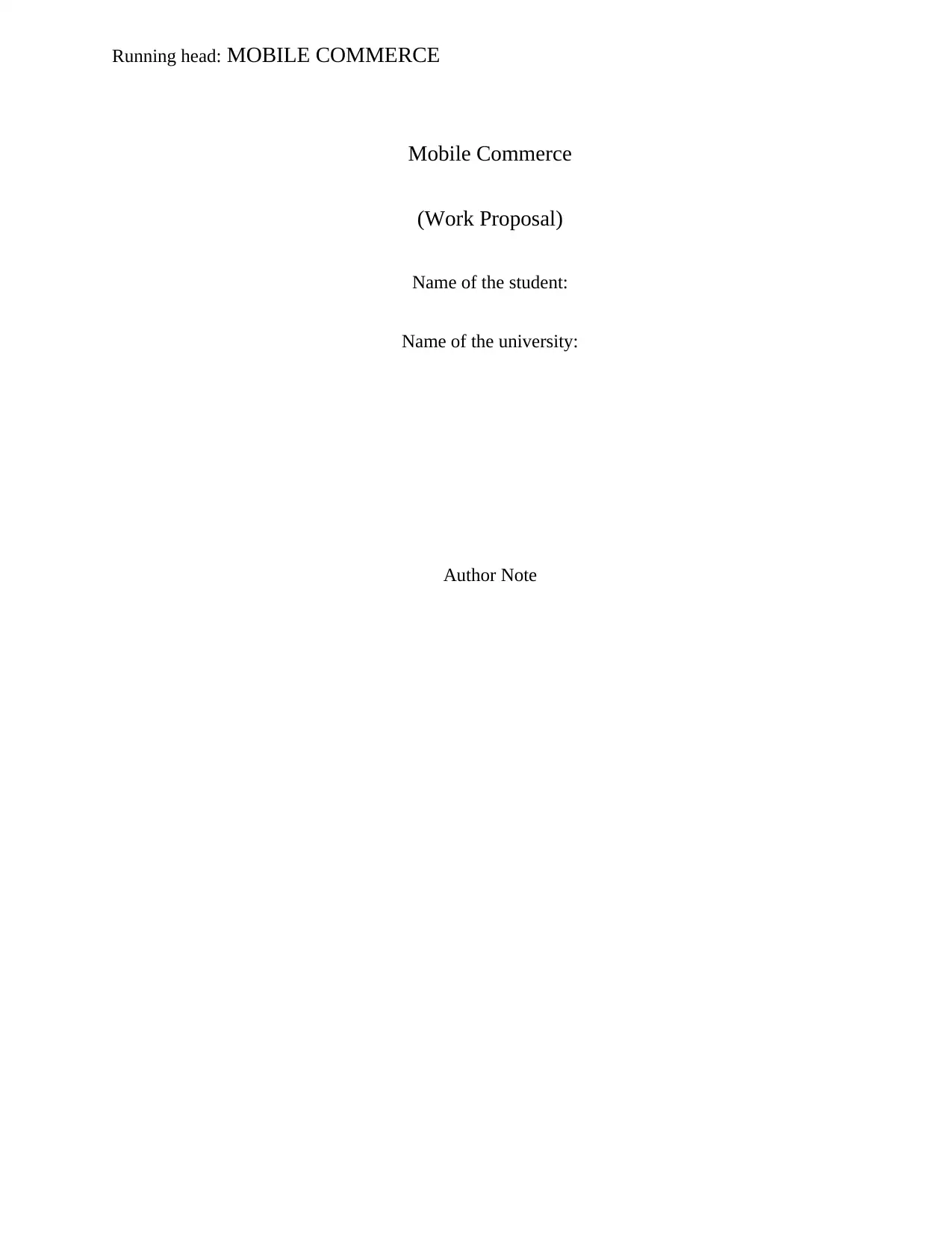
Running head: MOBILE COMMERCE
Mobile Commerce
(Work Proposal)
Name of the student:
Name of the university:
Author Note
Mobile Commerce
(Work Proposal)
Name of the student:
Name of the university:
Author Note
Paraphrase This Document
Need a fresh take? Get an instant paraphrase of this document with our AI Paraphraser
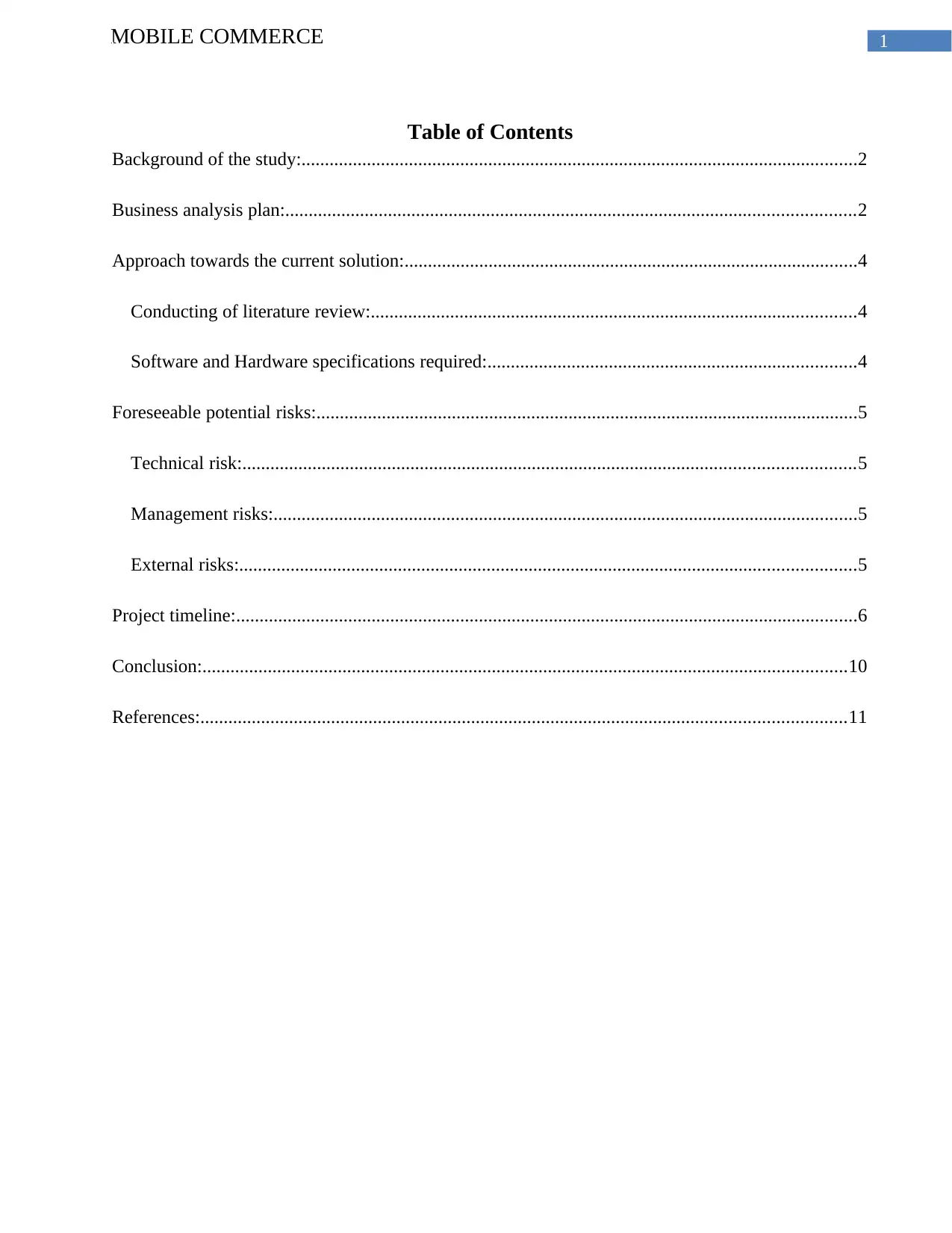
1MOBILE COMMERCE
Table of Contents
Background of the study:.......................................................................................................................2
Business analysis plan:..........................................................................................................................2
Approach towards the current solution:.................................................................................................4
Conducting of literature review:........................................................................................................4
Software and Hardware specifications required:...............................................................................4
Foreseeable potential risks:....................................................................................................................5
Technical risk:...................................................................................................................................5
Management risks:.............................................................................................................................5
External risks:....................................................................................................................................5
Project timeline:.....................................................................................................................................6
Conclusion:..........................................................................................................................................10
References:..........................................................................................................................................11
Table of Contents
Background of the study:.......................................................................................................................2
Business analysis plan:..........................................................................................................................2
Approach towards the current solution:.................................................................................................4
Conducting of literature review:........................................................................................................4
Software and Hardware specifications required:...............................................................................4
Foreseeable potential risks:....................................................................................................................5
Technical risk:...................................................................................................................................5
Management risks:.............................................................................................................................5
External risks:....................................................................................................................................5
Project timeline:.....................................................................................................................................6
Conclusion:..........................................................................................................................................10
References:..........................................................................................................................................11
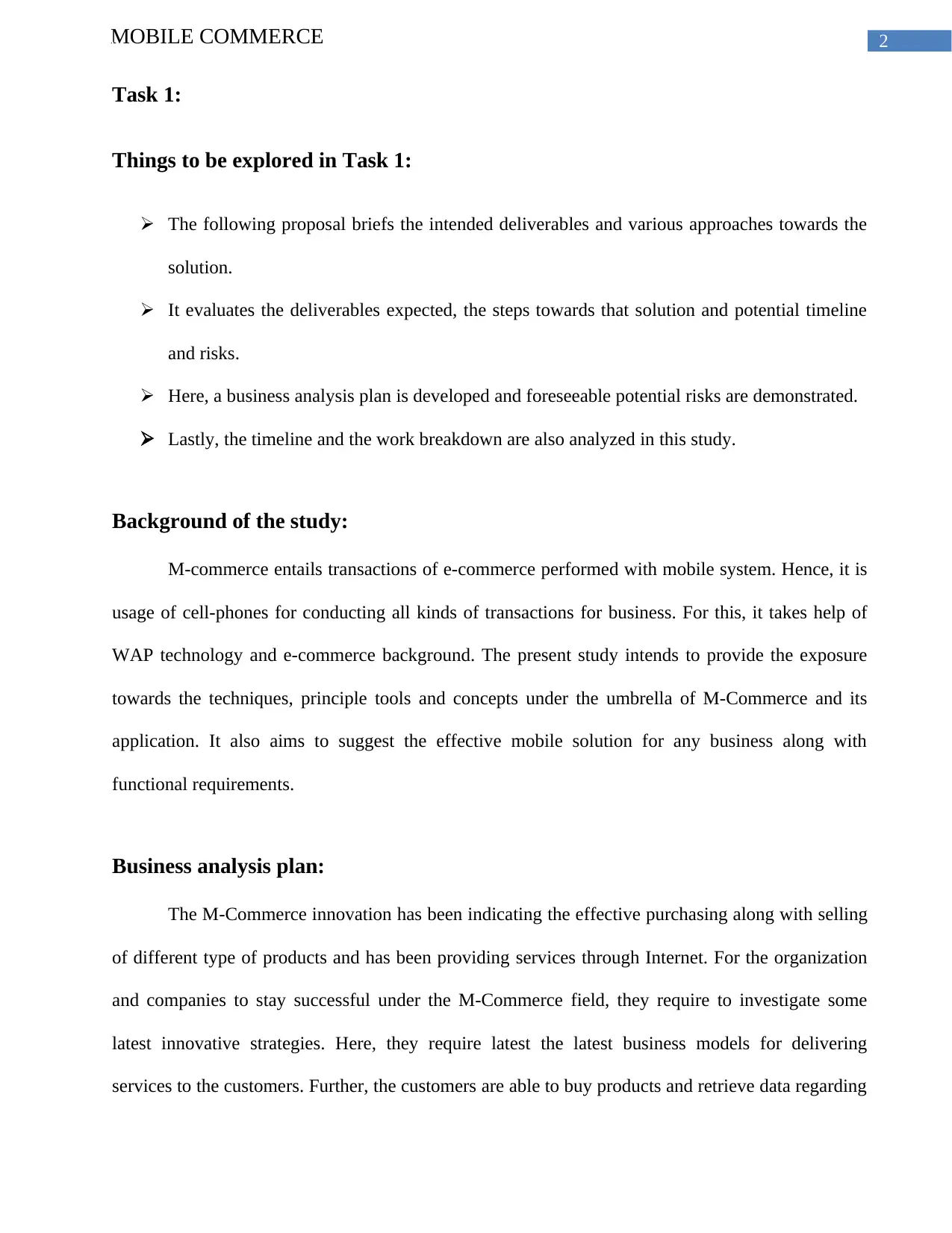
2MOBILE COMMERCE
Task 1:
Things to be explored in Task 1:
The following proposal briefs the intended deliverables and various approaches towards the
solution.
It evaluates the deliverables expected, the steps towards that solution and potential timeline
and risks.
Here, a business analysis plan is developed and foreseeable potential risks are demonstrated.
Lastly, the timeline and the work breakdown are also analyzed in this study.
Background of the study:
M-commerce entails transactions of e-commerce performed with mobile system. Hence, it is
usage of cell-phones for conducting all kinds of transactions for business. For this, it takes help of
WAP technology and e-commerce background. The present study intends to provide the exposure
towards the techniques, principle tools and concepts under the umbrella of M-Commerce and its
application. It also aims to suggest the effective mobile solution for any business along with
functional requirements.
Business analysis plan:
The M-Commerce innovation has been indicating the effective purchasing along with selling
of different type of products and has been providing services through Internet. For the organization
and companies to stay successful under the M-Commerce field, they require to investigate some
latest innovative strategies. Here, they require latest the latest business models for delivering
services to the customers. Further, the customers are able to buy products and retrieve data regarding
Task 1:
Things to be explored in Task 1:
The following proposal briefs the intended deliverables and various approaches towards the
solution.
It evaluates the deliverables expected, the steps towards that solution and potential timeline
and risks.
Here, a business analysis plan is developed and foreseeable potential risks are demonstrated.
Lastly, the timeline and the work breakdown are also analyzed in this study.
Background of the study:
M-commerce entails transactions of e-commerce performed with mobile system. Hence, it is
usage of cell-phones for conducting all kinds of transactions for business. For this, it takes help of
WAP technology and e-commerce background. The present study intends to provide the exposure
towards the techniques, principle tools and concepts under the umbrella of M-Commerce and its
application. It also aims to suggest the effective mobile solution for any business along with
functional requirements.
Business analysis plan:
The M-Commerce innovation has been indicating the effective purchasing along with selling
of different type of products and has been providing services through Internet. For the organization
and companies to stay successful under the M-Commerce field, they require to investigate some
latest innovative strategies. Here, they require latest the latest business models for delivering
services to the customers. Further, the customers are able to buy products and retrieve data regarding
⊘ This is a preview!⊘
Do you want full access?
Subscribe today to unlock all pages.

Trusted by 1+ million students worldwide
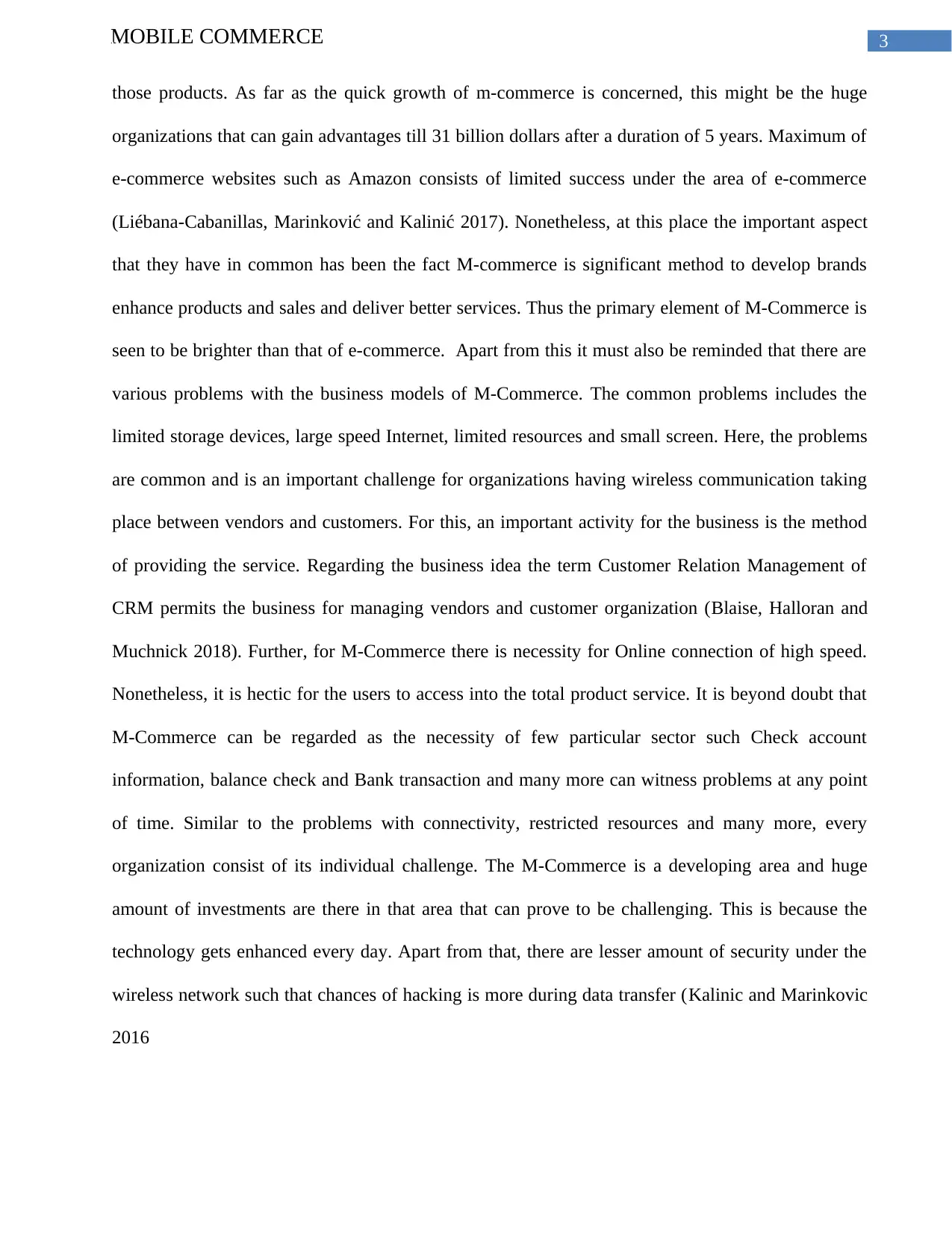
3MOBILE COMMERCE
those products. As far as the quick growth of m-commerce is concerned, this might be the huge
organizations that can gain advantages till 31 billion dollars after a duration of 5 years. Maximum of
e-commerce websites such as Amazon consists of limited success under the area of e-commerce
(Liébana-Cabanillas, Marinković and Kalinić 2017). Nonetheless, at this place the important aspect
that they have in common has been the fact M-commerce is significant method to develop brands
enhance products and sales and deliver better services. Thus the primary element of M-Commerce is
seen to be brighter than that of e-commerce. Apart from this it must also be reminded that there are
various problems with the business models of M-Commerce. The common problems includes the
limited storage devices, large speed Internet, limited resources and small screen. Here, the problems
are common and is an important challenge for organizations having wireless communication taking
place between vendors and customers. For this, an important activity for the business is the method
of providing the service. Regarding the business idea the term Customer Relation Management of
CRM permits the business for managing vendors and customer organization (Blaise, Halloran and
Muchnick 2018). Further, for M-Commerce there is necessity for Online connection of high speed.
Nonetheless, it is hectic for the users to access into the total product service. It is beyond doubt that
M-Commerce can be regarded as the necessity of few particular sector such Check account
information, balance check and Bank transaction and many more can witness problems at any point
of time. Similar to the problems with connectivity, restricted resources and many more, every
organization consist of its individual challenge. The M-Commerce is a developing area and huge
amount of investments are there in that area that can prove to be challenging. This is because the
technology gets enhanced every day. Apart from that, there are lesser amount of security under the
wireless network such that chances of hacking is more during data transfer (Kalinic and Marinkovic
2016
those products. As far as the quick growth of m-commerce is concerned, this might be the huge
organizations that can gain advantages till 31 billion dollars after a duration of 5 years. Maximum of
e-commerce websites such as Amazon consists of limited success under the area of e-commerce
(Liébana-Cabanillas, Marinković and Kalinić 2017). Nonetheless, at this place the important aspect
that they have in common has been the fact M-commerce is significant method to develop brands
enhance products and sales and deliver better services. Thus the primary element of M-Commerce is
seen to be brighter than that of e-commerce. Apart from this it must also be reminded that there are
various problems with the business models of M-Commerce. The common problems includes the
limited storage devices, large speed Internet, limited resources and small screen. Here, the problems
are common and is an important challenge for organizations having wireless communication taking
place between vendors and customers. For this, an important activity for the business is the method
of providing the service. Regarding the business idea the term Customer Relation Management of
CRM permits the business for managing vendors and customer organization (Blaise, Halloran and
Muchnick 2018). Further, for M-Commerce there is necessity for Online connection of high speed.
Nonetheless, it is hectic for the users to access into the total product service. It is beyond doubt that
M-Commerce can be regarded as the necessity of few particular sector such Check account
information, balance check and Bank transaction and many more can witness problems at any point
of time. Similar to the problems with connectivity, restricted resources and many more, every
organization consist of its individual challenge. The M-Commerce is a developing area and huge
amount of investments are there in that area that can prove to be challenging. This is because the
technology gets enhanced every day. Apart from that, there are lesser amount of security under the
wireless network such that chances of hacking is more during data transfer (Kalinic and Marinkovic
2016
Paraphrase This Document
Need a fresh take? Get an instant paraphrase of this document with our AI Paraphraser
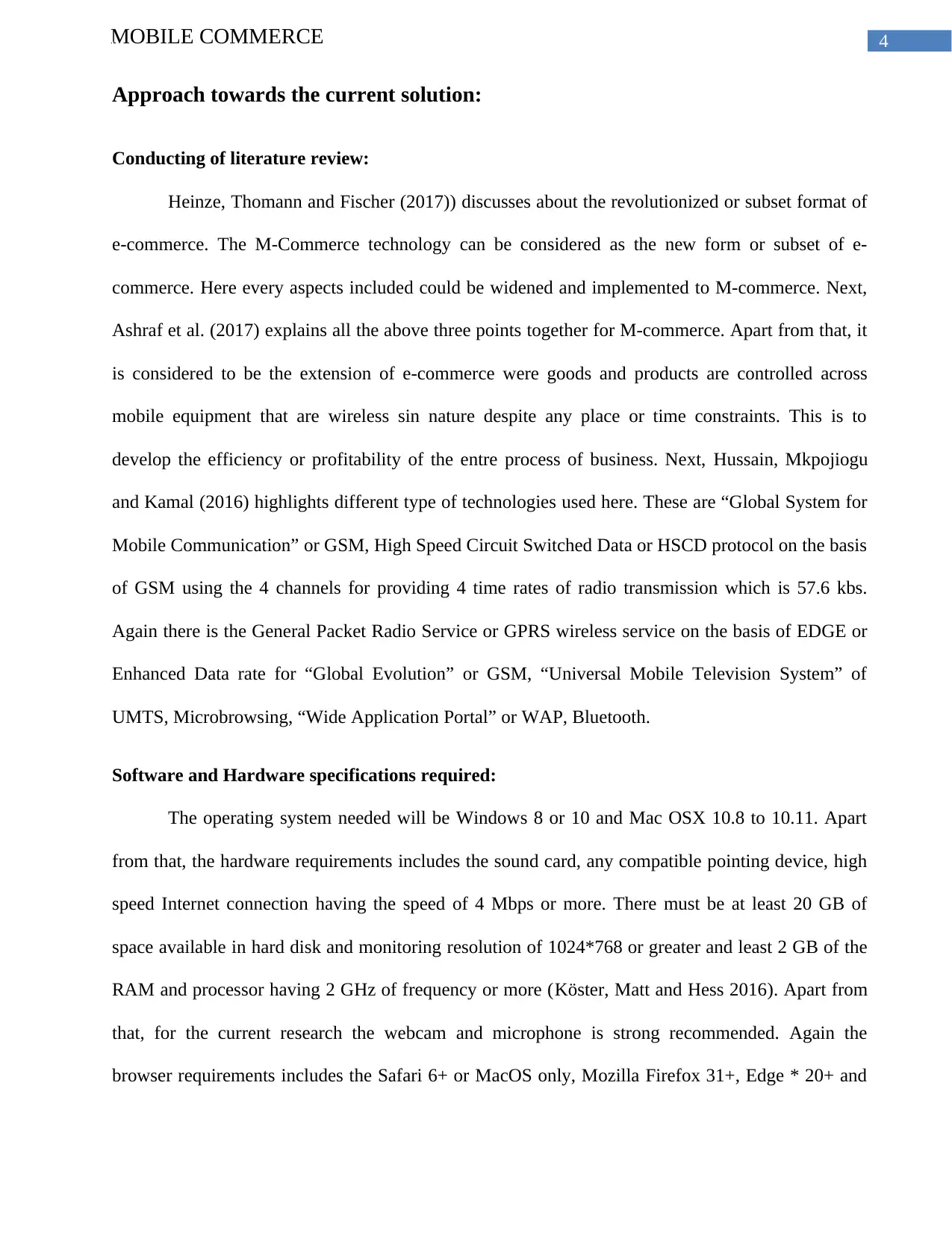
4MOBILE COMMERCE
Approach towards the current solution:
Conducting of literature review:
Heinze, Thomann and Fischer (2017)) discusses about the revolutionized or subset format of
e-commerce. The M-Commerce technology can be considered as the new form or subset of e-
commerce. Here every aspects included could be widened and implemented to M-commerce. Next,
Ashraf et al. (2017) explains all the above three points together for M-commerce. Apart from that, it
is considered to be the extension of e-commerce were goods and products are controlled across
mobile equipment that are wireless sin nature despite any place or time constraints. This is to
develop the efficiency or profitability of the entre process of business. Next, Hussain, Mkpojiogu
and Kamal (2016) highlights different type of technologies used here. These are “Global System for
Mobile Communication” or GSM, High Speed Circuit Switched Data or HSCD protocol on the basis
of GSM using the 4 channels for providing 4 time rates of radio transmission which is 57.6 kbs.
Again there is the General Packet Radio Service or GPRS wireless service on the basis of EDGE or
Enhanced Data rate for “Global Evolution” or GSM, “Universal Mobile Television System” of
UMTS, Microbrowsing, “Wide Application Portal” or WAP, Bluetooth.
Software and Hardware specifications required:
The operating system needed will be Windows 8 or 10 and Mac OSX 10.8 to 10.11. Apart
from that, the hardware requirements includes the sound card, any compatible pointing device, high
speed Internet connection having the speed of 4 Mbps or more. There must be at least 20 GB of
space available in hard disk and monitoring resolution of 1024*768 or greater and least 2 GB of the
RAM and processor having 2 GHz of frequency or more (Köster, Matt and Hess 2016). Apart from
that, for the current research the webcam and microphone is strong recommended. Again the
browser requirements includes the Safari 6+ or MacOS only, Mozilla Firefox 31+, Edge * 20+ and
Approach towards the current solution:
Conducting of literature review:
Heinze, Thomann and Fischer (2017)) discusses about the revolutionized or subset format of
e-commerce. The M-Commerce technology can be considered as the new form or subset of e-
commerce. Here every aspects included could be widened and implemented to M-commerce. Next,
Ashraf et al. (2017) explains all the above three points together for M-commerce. Apart from that, it
is considered to be the extension of e-commerce were goods and products are controlled across
mobile equipment that are wireless sin nature despite any place or time constraints. This is to
develop the efficiency or profitability of the entre process of business. Next, Hussain, Mkpojiogu
and Kamal (2016) highlights different type of technologies used here. These are “Global System for
Mobile Communication” or GSM, High Speed Circuit Switched Data or HSCD protocol on the basis
of GSM using the 4 channels for providing 4 time rates of radio transmission which is 57.6 kbs.
Again there is the General Packet Radio Service or GPRS wireless service on the basis of EDGE or
Enhanced Data rate for “Global Evolution” or GSM, “Universal Mobile Television System” of
UMTS, Microbrowsing, “Wide Application Portal” or WAP, Bluetooth.
Software and Hardware specifications required:
The operating system needed will be Windows 8 or 10 and Mac OSX 10.8 to 10.11. Apart
from that, the hardware requirements includes the sound card, any compatible pointing device, high
speed Internet connection having the speed of 4 Mbps or more. There must be at least 20 GB of
space available in hard disk and monitoring resolution of 1024*768 or greater and least 2 GB of the
RAM and processor having 2 GHz of frequency or more (Köster, Matt and Hess 2016). Apart from
that, for the current research the webcam and microphone is strong recommended. Again the
browser requirements includes the Safari 6+ or MacOS only, Mozilla Firefox 31+, Edge * 20+ and
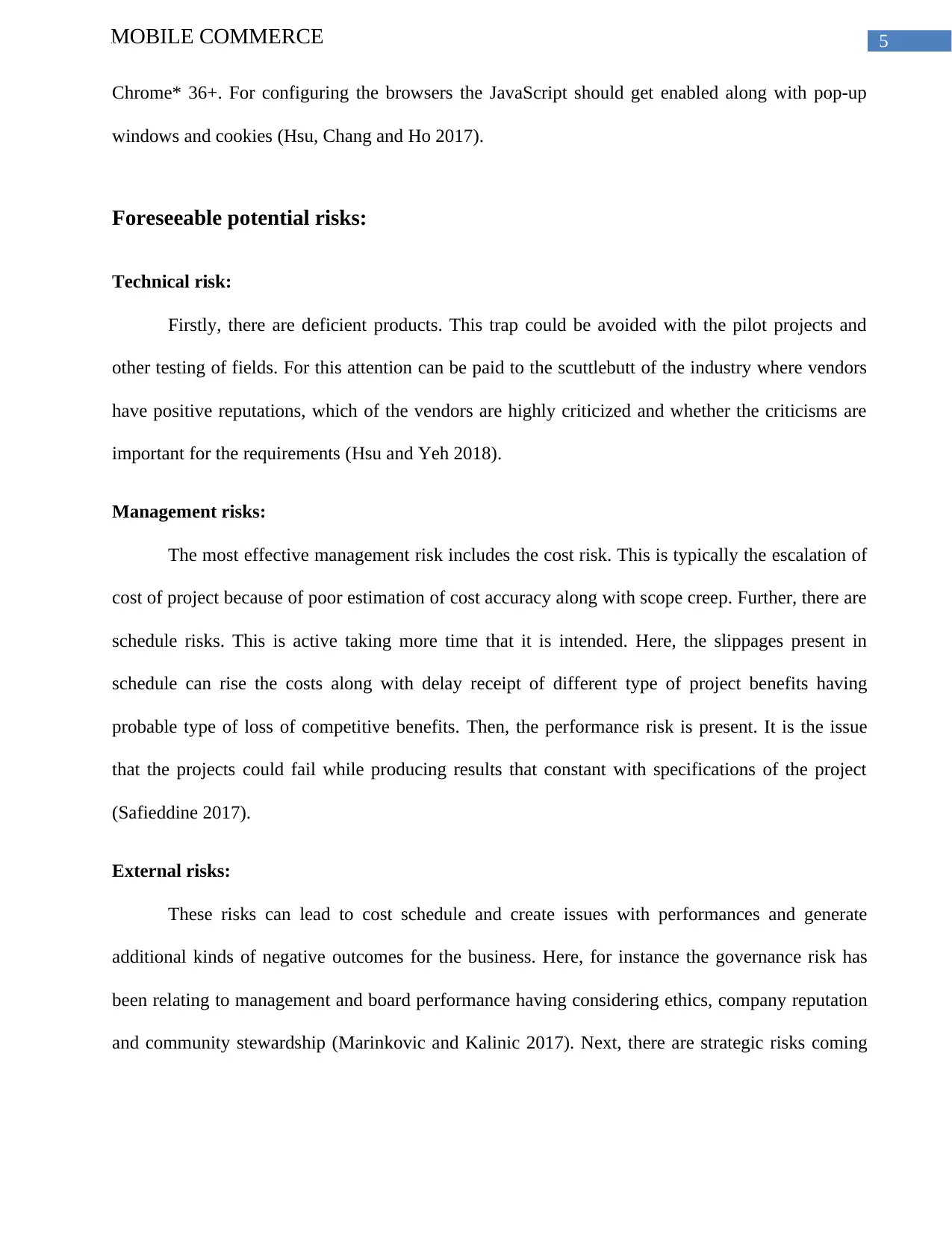
5MOBILE COMMERCE
Chrome* 36+. For configuring the browsers the JavaScript should get enabled along with pop-up
windows and cookies (Hsu, Chang and Ho 2017).
Foreseeable potential risks:
Technical risk:
Firstly, there are deficient products. This trap could be avoided with the pilot projects and
other testing of fields. For this attention can be paid to the scuttlebutt of the industry where vendors
have positive reputations, which of the vendors are highly criticized and whether the criticisms are
important for the requirements (Hsu and Yeh 2018).
Management risks:
The most effective management risk includes the cost risk. This is typically the escalation of
cost of project because of poor estimation of cost accuracy along with scope creep. Further, there are
schedule risks. This is active taking more time that it is intended. Here, the slippages present in
schedule can rise the costs along with delay receipt of different type of project benefits having
probable type of loss of competitive benefits. Then, the performance risk is present. It is the issue
that the projects could fail while producing results that constant with specifications of the project
(Safieddine 2017).
External risks:
These risks can lead to cost schedule and create issues with performances and generate
additional kinds of negative outcomes for the business. Here, for instance the governance risk has
been relating to management and board performance having considering ethics, company reputation
and community stewardship (Marinkovic and Kalinic 2017). Next, there are strategic risks coming
Chrome* 36+. For configuring the browsers the JavaScript should get enabled along with pop-up
windows and cookies (Hsu, Chang and Ho 2017).
Foreseeable potential risks:
Technical risk:
Firstly, there are deficient products. This trap could be avoided with the pilot projects and
other testing of fields. For this attention can be paid to the scuttlebutt of the industry where vendors
have positive reputations, which of the vendors are highly criticized and whether the criticisms are
important for the requirements (Hsu and Yeh 2018).
Management risks:
The most effective management risk includes the cost risk. This is typically the escalation of
cost of project because of poor estimation of cost accuracy along with scope creep. Further, there are
schedule risks. This is active taking more time that it is intended. Here, the slippages present in
schedule can rise the costs along with delay receipt of different type of project benefits having
probable type of loss of competitive benefits. Then, the performance risk is present. It is the issue
that the projects could fail while producing results that constant with specifications of the project
(Safieddine 2017).
External risks:
These risks can lead to cost schedule and create issues with performances and generate
additional kinds of negative outcomes for the business. Here, for instance the governance risk has
been relating to management and board performance having considering ethics, company reputation
and community stewardship (Marinkovic and Kalinic 2017). Next, there are strategic risks coming
⊘ This is a preview!⊘
Do you want full access?
Subscribe today to unlock all pages.

Trusted by 1+ million students worldwide
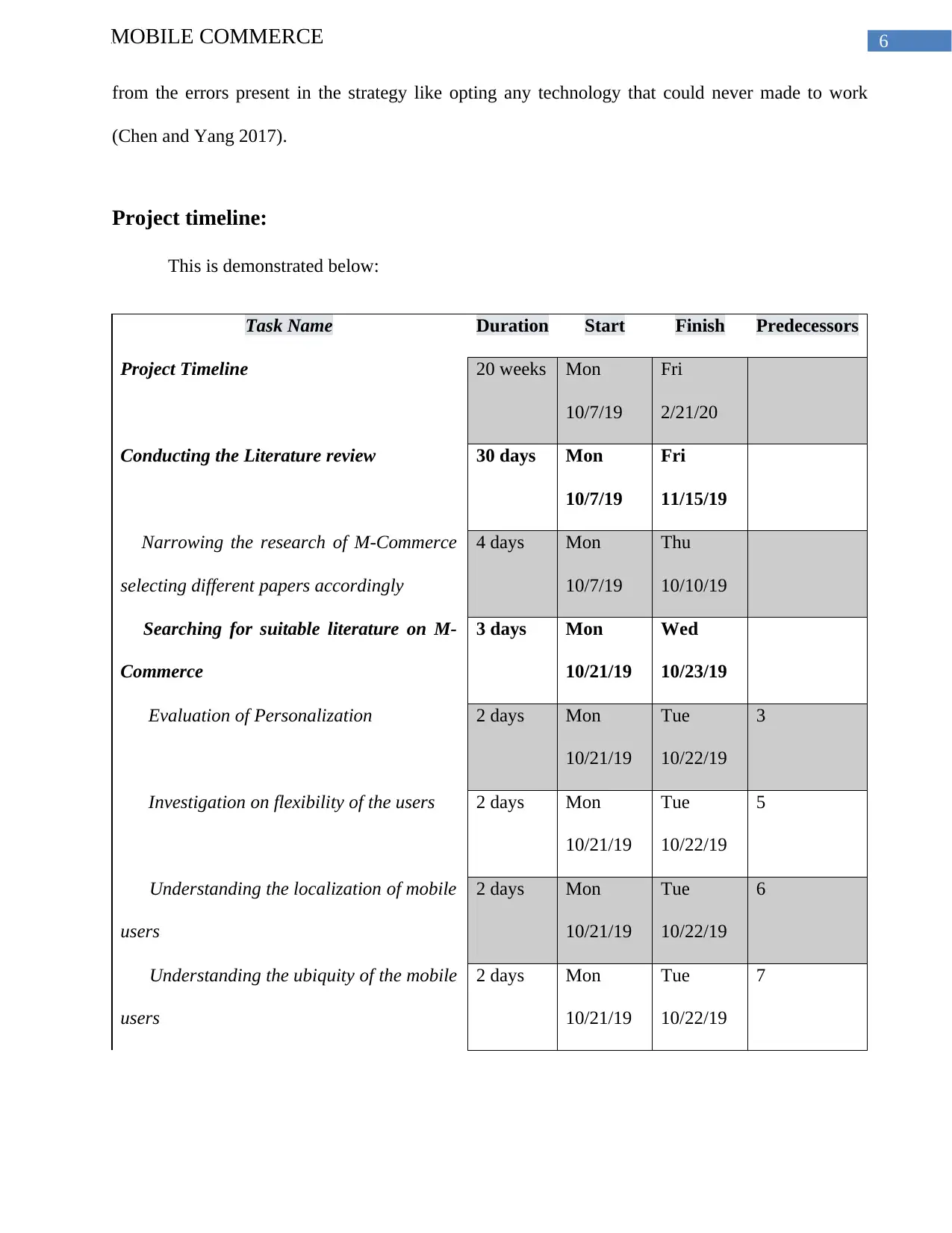
6MOBILE COMMERCE
from the errors present in the strategy like opting any technology that could never made to work
(Chen and Yang 2017).
Project timeline:
This is demonstrated below:
Task Name Duration Start Finish Predecessors
Project Timeline 20 weeks Mon
10/7/19
Fri
2/21/20
Conducting the Literature review 30 days Mon
10/7/19
Fri
11/15/19
Narrowing the research of M-Commerce
selecting different papers accordingly
4 days Mon
10/7/19
Thu
10/10/19
Searching for suitable literature on M-
Commerce
3 days Mon
10/21/19
Wed
10/23/19
Evaluation of Personalization 2 days Mon
10/21/19
Tue
10/22/19
3
Investigation on flexibility of the users 2 days Mon
10/21/19
Tue
10/22/19
5
Understanding the localization of mobile
users
2 days Mon
10/21/19
Tue
10/22/19
6
Understanding the ubiquity of the mobile
users
2 days Mon
10/21/19
Tue
10/22/19
7
from the errors present in the strategy like opting any technology that could never made to work
(Chen and Yang 2017).
Project timeline:
This is demonstrated below:
Task Name Duration Start Finish Predecessors
Project Timeline 20 weeks Mon
10/7/19
Fri
2/21/20
Conducting the Literature review 30 days Mon
10/7/19
Fri
11/15/19
Narrowing the research of M-Commerce
selecting different papers accordingly
4 days Mon
10/7/19
Thu
10/10/19
Searching for suitable literature on M-
Commerce
3 days Mon
10/21/19
Wed
10/23/19
Evaluation of Personalization 2 days Mon
10/21/19
Tue
10/22/19
3
Investigation on flexibility of the users 2 days Mon
10/21/19
Tue
10/22/19
5
Understanding the localization of mobile
users
2 days Mon
10/21/19
Tue
10/22/19
6
Understanding the ubiquity of the mobile
users
2 days Mon
10/21/19
Tue
10/22/19
7
Paraphrase This Document
Need a fresh take? Get an instant paraphrase of this document with our AI Paraphraser
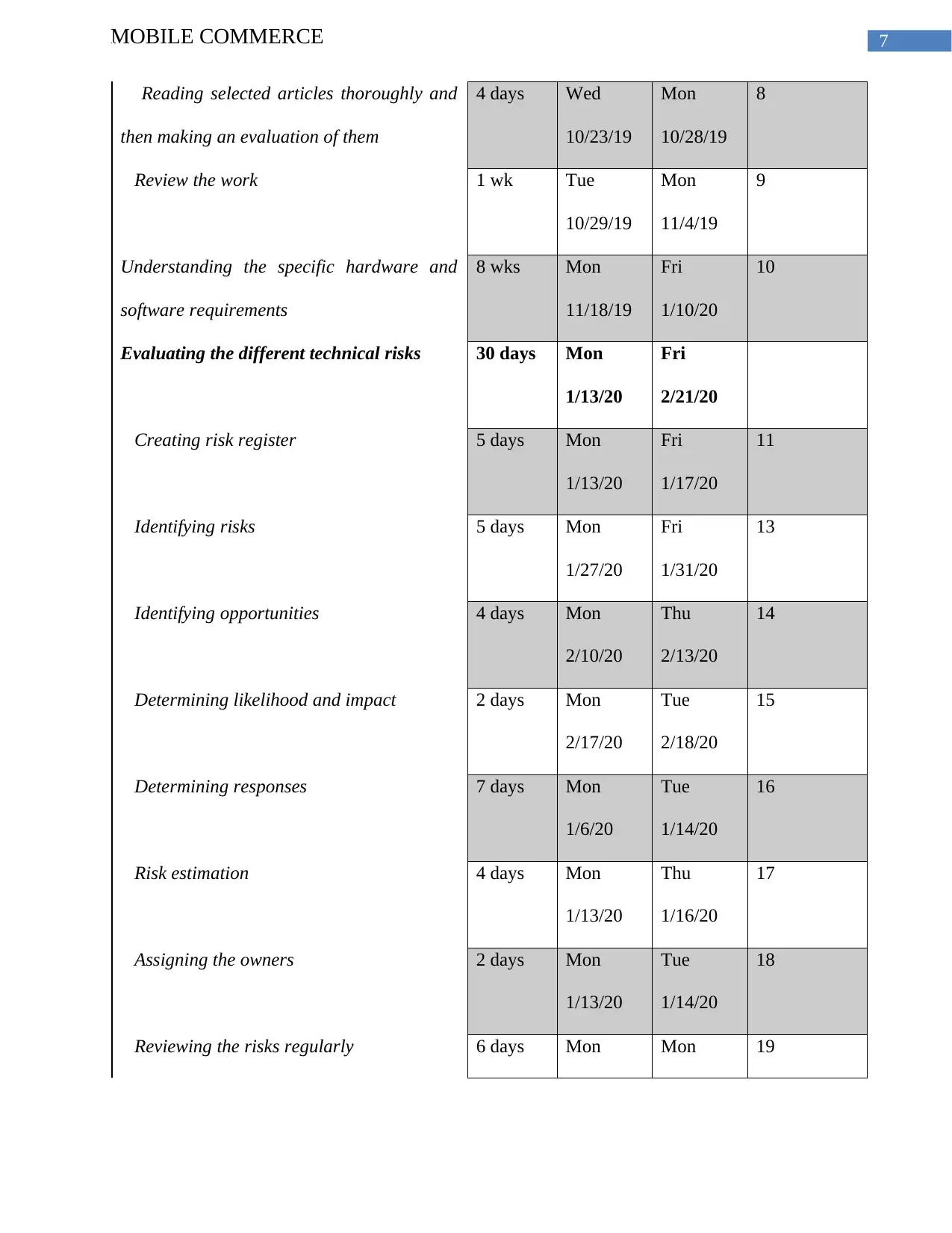
7MOBILE COMMERCE
Reading selected articles thoroughly and
then making an evaluation of them
4 days Wed
10/23/19
Mon
10/28/19
8
Review the work 1 wk Tue
10/29/19
Mon
11/4/19
9
Understanding the specific hardware and
software requirements
8 wks Mon
11/18/19
Fri
1/10/20
10
Evaluating the different technical risks 30 days Mon
1/13/20
Fri
2/21/20
Creating risk register 5 days Mon
1/13/20
Fri
1/17/20
11
Identifying risks 5 days Mon
1/27/20
Fri
1/31/20
13
Identifying opportunities 4 days Mon
2/10/20
Thu
2/13/20
14
Determining likelihood and impact 2 days Mon
2/17/20
Tue
2/18/20
15
Determining responses 7 days Mon
1/6/20
Tue
1/14/20
16
Risk estimation 4 days Mon
1/13/20
Thu
1/16/20
17
Assigning the owners 2 days Mon
1/13/20
Tue
1/14/20
18
Reviewing the risks regularly 6 days Mon Mon 19
Reading selected articles thoroughly and
then making an evaluation of them
4 days Wed
10/23/19
Mon
10/28/19
8
Review the work 1 wk Tue
10/29/19
Mon
11/4/19
9
Understanding the specific hardware and
software requirements
8 wks Mon
11/18/19
Fri
1/10/20
10
Evaluating the different technical risks 30 days Mon
1/13/20
Fri
2/21/20
Creating risk register 5 days Mon
1/13/20
Fri
1/17/20
11
Identifying risks 5 days Mon
1/27/20
Fri
1/31/20
13
Identifying opportunities 4 days Mon
2/10/20
Thu
2/13/20
14
Determining likelihood and impact 2 days Mon
2/17/20
Tue
2/18/20
15
Determining responses 7 days Mon
1/6/20
Tue
1/14/20
16
Risk estimation 4 days Mon
1/13/20
Thu
1/16/20
17
Assigning the owners 2 days Mon
1/13/20
Tue
1/14/20
18
Reviewing the risks regularly 6 days Mon Mon 19
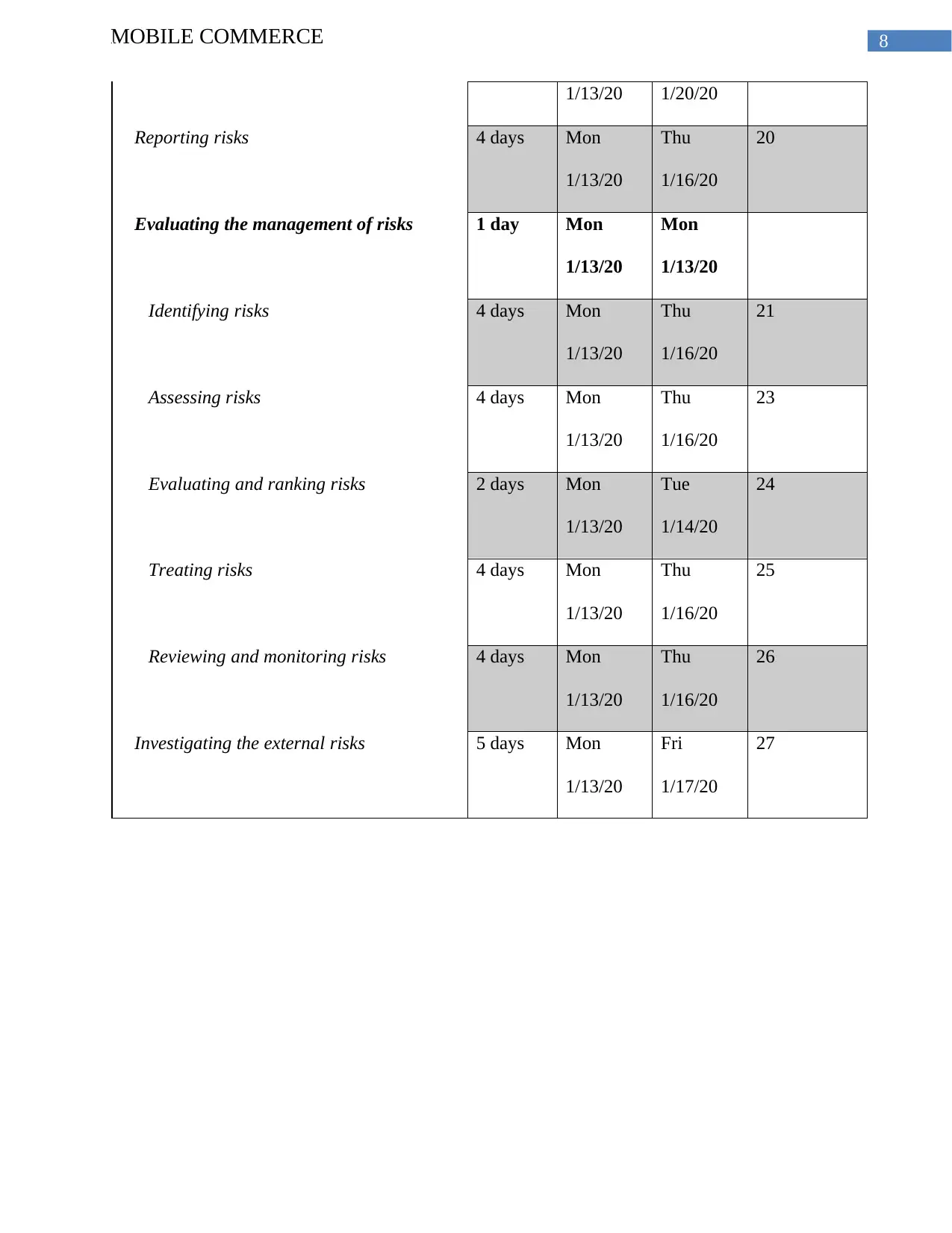
8MOBILE COMMERCE
1/13/20 1/20/20
Reporting risks 4 days Mon
1/13/20
Thu
1/16/20
20
Evaluating the management of risks 1 day Mon
1/13/20
Mon
1/13/20
Identifying risks 4 days Mon
1/13/20
Thu
1/16/20
21
Assessing risks 4 days Mon
1/13/20
Thu
1/16/20
23
Evaluating and ranking risks 2 days Mon
1/13/20
Tue
1/14/20
24
Treating risks 4 days Mon
1/13/20
Thu
1/16/20
25
Reviewing and monitoring risks 4 days Mon
1/13/20
Thu
1/16/20
26
Investigating the external risks 5 days Mon
1/13/20
Fri
1/17/20
27
1/13/20 1/20/20
Reporting risks 4 days Mon
1/13/20
Thu
1/16/20
20
Evaluating the management of risks 1 day Mon
1/13/20
Mon
1/13/20
Identifying risks 4 days Mon
1/13/20
Thu
1/16/20
21
Assessing risks 4 days Mon
1/13/20
Thu
1/16/20
23
Evaluating and ranking risks 2 days Mon
1/13/20
Tue
1/14/20
24
Treating risks 4 days Mon
1/13/20
Thu
1/16/20
25
Reviewing and monitoring risks 4 days Mon
1/13/20
Thu
1/16/20
26
Investigating the external risks 5 days Mon
1/13/20
Fri
1/17/20
27
⊘ This is a preview!⊘
Do you want full access?
Subscribe today to unlock all pages.

Trusted by 1+ million students worldwide
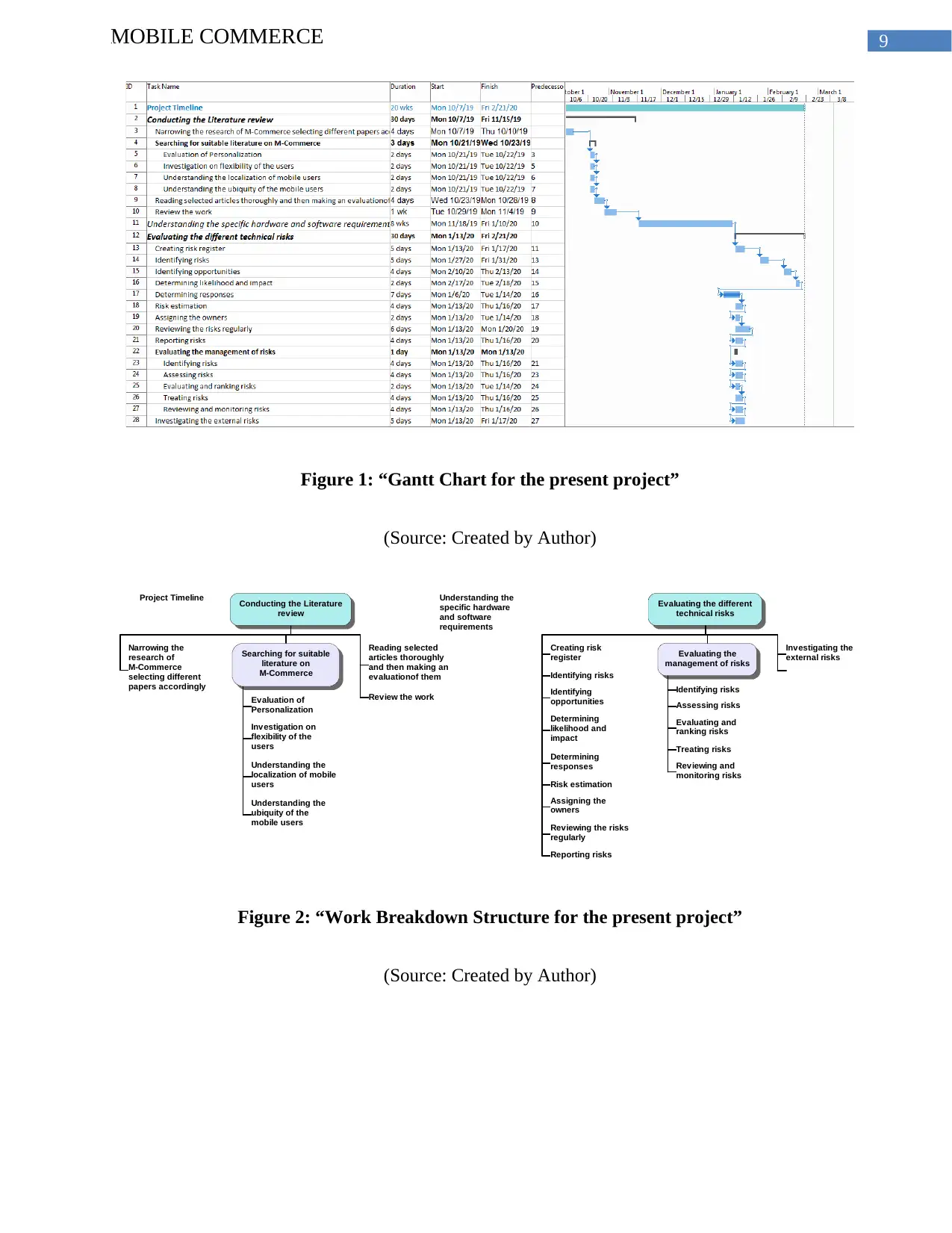
9MOBILE COMMERCE
Figure 1: “Gantt Chart for the present project”
(Source: Created by Author)
Project Timeline Conducting the Literature
review
Narrowing the
research of
M-Commerce
selecting different
papers accordingly
Searching for suitable
literature on
M-Commerce
Evaluation of
Personalization
Investigation on
flexibility of the
users
Understanding the
localization of mobile
users
Understanding the
ubiquity of the
mobile users
Reading selected
articles thoroughly
and then making an
evaluationof them
Review the work
Understanding the
specific hardware
and software
requirements
Evaluating the different
technical risks
Creating risk
register
Identifying risks
Identifying
opportunities
Determining
likelihood and
impact
Determining
responses
Risk estimation
Assigning the
owners
Reviewing the risks
regularly
Reporting risks
Evaluating the
management of risks
Identifying risks
Assessing risks
Evaluating and
ranking risks
Treating risks
Reviewing and
monitoring risks
Investigating the
external risks
Figure 2: “Work Breakdown Structure for the present project”
(Source: Created by Author)
Figure 1: “Gantt Chart for the present project”
(Source: Created by Author)
Project Timeline Conducting the Literature
review
Narrowing the
research of
M-Commerce
selecting different
papers accordingly
Searching for suitable
literature on
M-Commerce
Evaluation of
Personalization
Investigation on
flexibility of the
users
Understanding the
localization of mobile
users
Understanding the
ubiquity of the
mobile users
Reading selected
articles thoroughly
and then making an
evaluationof them
Review the work
Understanding the
specific hardware
and software
requirements
Evaluating the different
technical risks
Creating risk
register
Identifying risks
Identifying
opportunities
Determining
likelihood and
impact
Determining
responses
Risk estimation
Assigning the
owners
Reviewing the risks
regularly
Reporting risks
Evaluating the
management of risks
Identifying risks
Assessing risks
Evaluating and
ranking risks
Treating risks
Reviewing and
monitoring risks
Investigating the
external risks
Figure 2: “Work Breakdown Structure for the present project”
(Source: Created by Author)
Paraphrase This Document
Need a fresh take? Get an instant paraphrase of this document with our AI Paraphraser
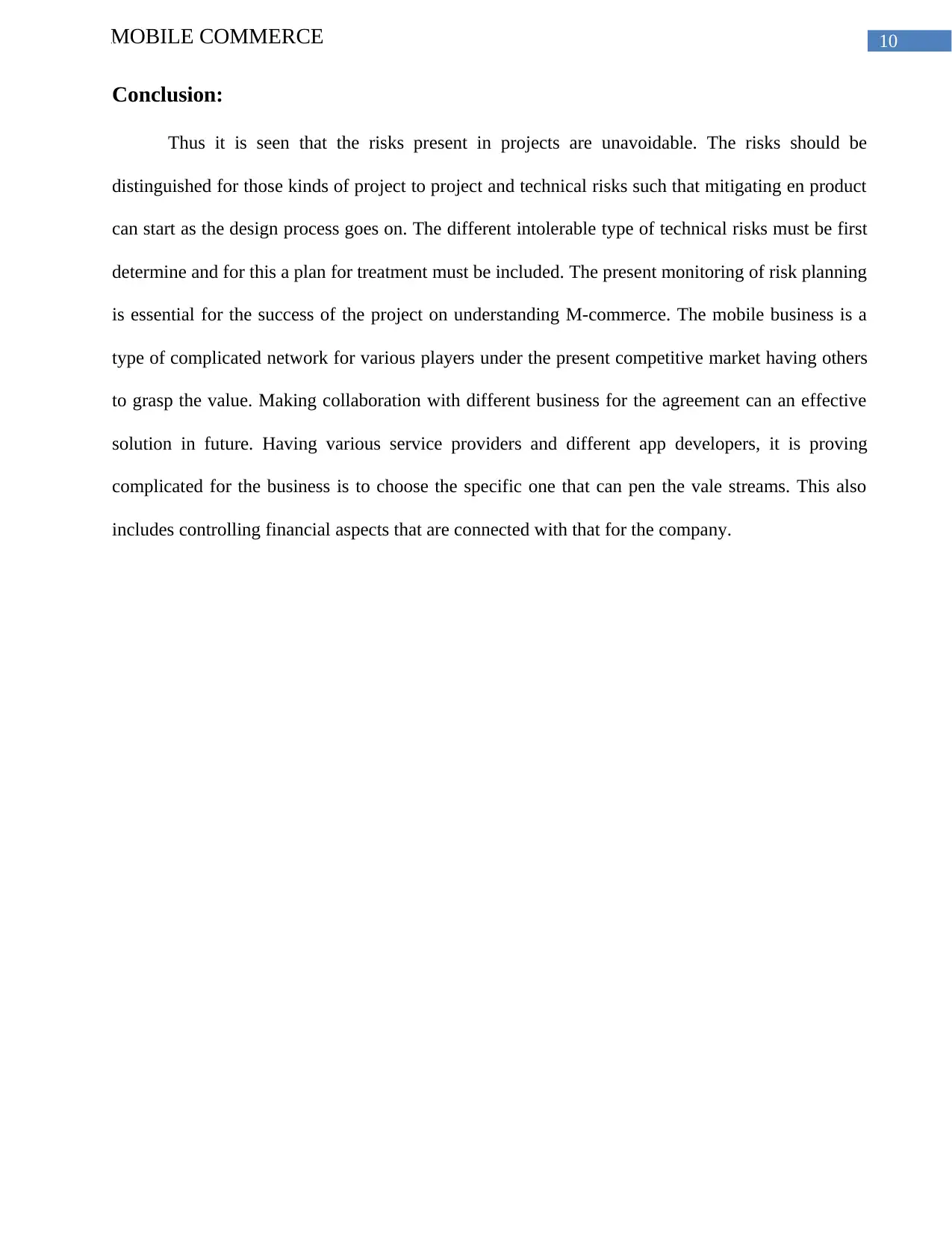
10MOBILE COMMERCE
Conclusion:
Thus it is seen that the risks present in projects are unavoidable. The risks should be
distinguished for those kinds of project to project and technical risks such that mitigating en product
can start as the design process goes on. The different intolerable type of technical risks must be first
determine and for this a plan for treatment must be included. The present monitoring of risk planning
is essential for the success of the project on understanding M-commerce. The mobile business is a
type of complicated network for various players under the present competitive market having others
to grasp the value. Making collaboration with different business for the agreement can an effective
solution in future. Having various service providers and different app developers, it is proving
complicated for the business is to choose the specific one that can pen the vale streams. This also
includes controlling financial aspects that are connected with that for the company.
Conclusion:
Thus it is seen that the risks present in projects are unavoidable. The risks should be
distinguished for those kinds of project to project and technical risks such that mitigating en product
can start as the design process goes on. The different intolerable type of technical risks must be first
determine and for this a plan for treatment must be included. The present monitoring of risk planning
is essential for the success of the project on understanding M-commerce. The mobile business is a
type of complicated network for various players under the present competitive market having others
to grasp the value. Making collaboration with different business for the agreement can an effective
solution in future. Having various service providers and different app developers, it is proving
complicated for the business is to choose the specific one that can pen the vale streams. This also
includes controlling financial aspects that are connected with that for the company.
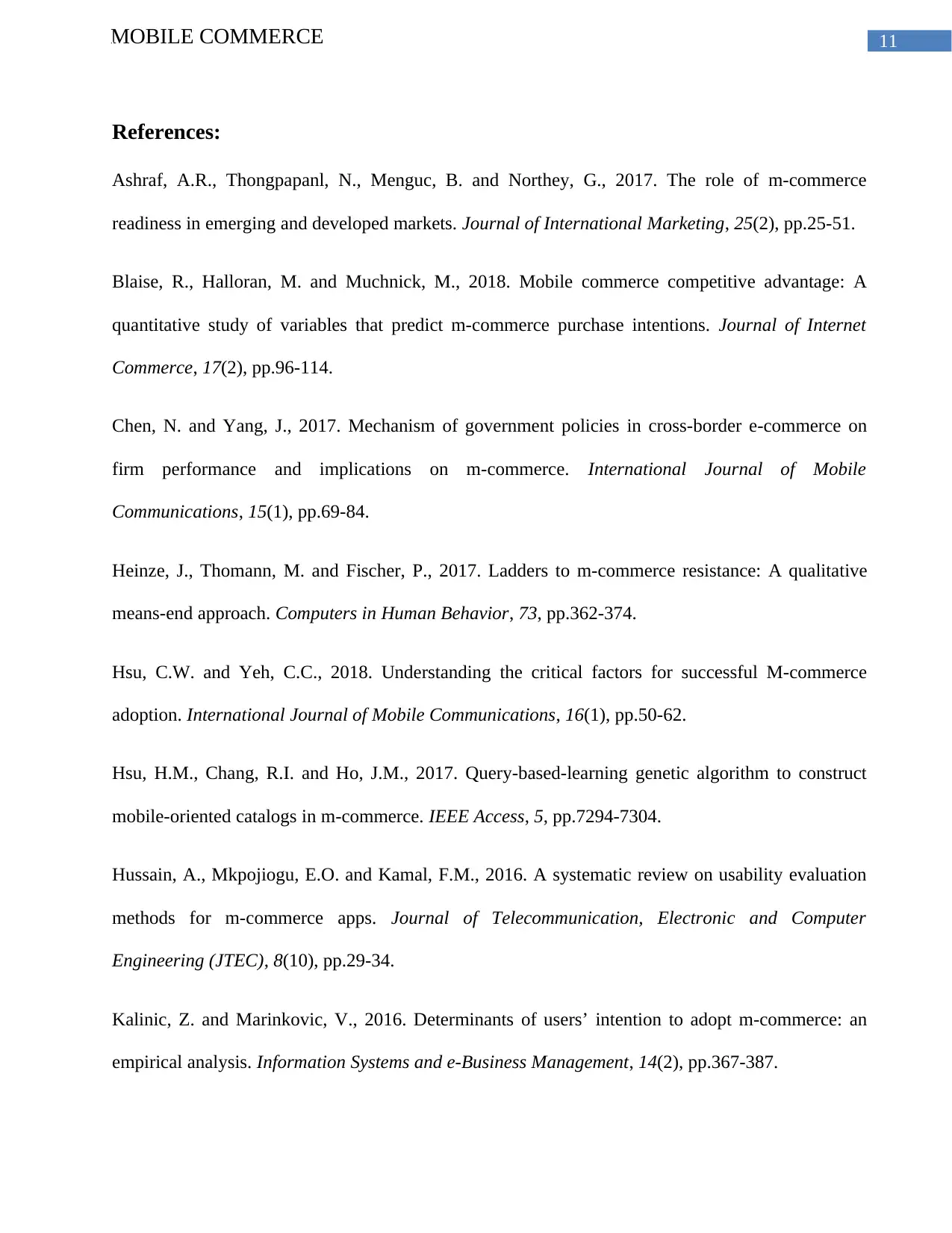
11MOBILE COMMERCE
References:
Ashraf, A.R., Thongpapanl, N., Menguc, B. and Northey, G., 2017. The role of m-commerce
readiness in emerging and developed markets. Journal of International Marketing, 25(2), pp.25-51.
Blaise, R., Halloran, M. and Muchnick, M., 2018. Mobile commerce competitive advantage: A
quantitative study of variables that predict m-commerce purchase intentions. Journal of Internet
Commerce, 17(2), pp.96-114.
Chen, N. and Yang, J., 2017. Mechanism of government policies in cross-border e-commerce on
firm performance and implications on m-commerce. International Journal of Mobile
Communications, 15(1), pp.69-84.
Heinze, J., Thomann, M. and Fischer, P., 2017. Ladders to m-commerce resistance: A qualitative
means-end approach. Computers in Human Behavior, 73, pp.362-374.
Hsu, C.W. and Yeh, C.C., 2018. Understanding the critical factors for successful M-commerce
adoption. International Journal of Mobile Communications, 16(1), pp.50-62.
Hsu, H.M., Chang, R.I. and Ho, J.M., 2017. Query-based-learning genetic algorithm to construct
mobile-oriented catalogs in m-commerce. IEEE Access, 5, pp.7294-7304.
Hussain, A., Mkpojiogu, E.O. and Kamal, F.M., 2016. A systematic review on usability evaluation
methods for m-commerce apps. Journal of Telecommunication, Electronic and Computer
Engineering (JTEC), 8(10), pp.29-34.
Kalinic, Z. and Marinkovic, V., 2016. Determinants of users’ intention to adopt m-commerce: an
empirical analysis. Information Systems and e-Business Management, 14(2), pp.367-387.
References:
Ashraf, A.R., Thongpapanl, N., Menguc, B. and Northey, G., 2017. The role of m-commerce
readiness in emerging and developed markets. Journal of International Marketing, 25(2), pp.25-51.
Blaise, R., Halloran, M. and Muchnick, M., 2018. Mobile commerce competitive advantage: A
quantitative study of variables that predict m-commerce purchase intentions. Journal of Internet
Commerce, 17(2), pp.96-114.
Chen, N. and Yang, J., 2017. Mechanism of government policies in cross-border e-commerce on
firm performance and implications on m-commerce. International Journal of Mobile
Communications, 15(1), pp.69-84.
Heinze, J., Thomann, M. and Fischer, P., 2017. Ladders to m-commerce resistance: A qualitative
means-end approach. Computers in Human Behavior, 73, pp.362-374.
Hsu, C.W. and Yeh, C.C., 2018. Understanding the critical factors for successful M-commerce
adoption. International Journal of Mobile Communications, 16(1), pp.50-62.
Hsu, H.M., Chang, R.I. and Ho, J.M., 2017. Query-based-learning genetic algorithm to construct
mobile-oriented catalogs in m-commerce. IEEE Access, 5, pp.7294-7304.
Hussain, A., Mkpojiogu, E.O. and Kamal, F.M., 2016. A systematic review on usability evaluation
methods for m-commerce apps. Journal of Telecommunication, Electronic and Computer
Engineering (JTEC), 8(10), pp.29-34.
Kalinic, Z. and Marinkovic, V., 2016. Determinants of users’ intention to adopt m-commerce: an
empirical analysis. Information Systems and e-Business Management, 14(2), pp.367-387.
⊘ This is a preview!⊘
Do you want full access?
Subscribe today to unlock all pages.

Trusted by 1+ million students worldwide
1 out of 12
Related Documents
Your All-in-One AI-Powered Toolkit for Academic Success.
+13062052269
info@desklib.com
Available 24*7 on WhatsApp / Email
![[object Object]](/_next/static/media/star-bottom.7253800d.svg)
Unlock your academic potential
Copyright © 2020–2025 A2Z Services. All Rights Reserved. Developed and managed by ZUCOL.



